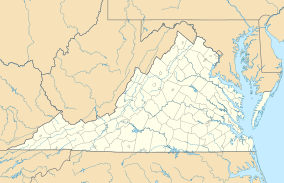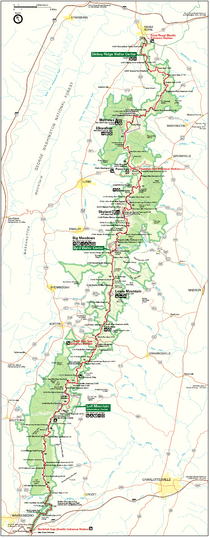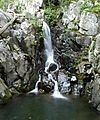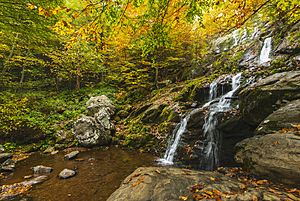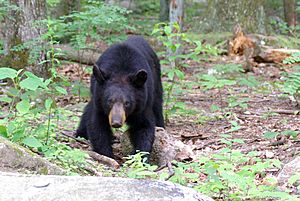Shenandoah National Park facts for kids
Quick facts for kids Shenandoah National Park |
|
|---|---|
|
IUCN Category II (National Park)
|
|
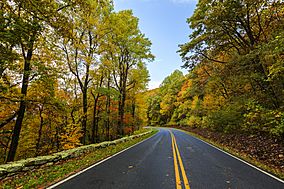
Skyline Drive
|
|
| Location | Virginia, United States |
| Nearest city | Front Royal |
| Area | 199,173 acres (311.208 sq mi; 806.02 km2) |
| Established | December 26, 1935 |
| Visitors | 1,264,880 (in 2018) |
| Governing body | National Park Service |
| Website | Shenandoah National Park |
Shenandoah National Park is a beautiful American national park located in the Blue Ridge Mountains of Virginia. This park is long and narrow. To its west, you'll find the Shenandoah River and its wide valley. To the east are the gentle, rolling hills of the Virginia Piedmont.
The main road through the park is Skyline Drive. It generally follows the mountain ridge. Nearly 40% of the park's land, about 79,579 acres (322.04 km²), is special wilderness area. This means it is kept wild and protected. The tallest mountain in the park is Hawksbill Mountain, which reaches 4,051 feet (1,235 meters) high.
Contents
Park Geography
Shenandoah National Park covers parts of eight counties in Virginia. On the west side of Skyline Drive, from north to south, are Warren, Page, Rockingham, and Augusta counties. On the east side, you'll find Rappahannock, Madison, Greene, and Albemarle counties.
The park stretches for 105 miles (169 km) along Skyline Drive. It goes from near the town of Front Royal in the north to near the city of Waynesboro in the south. The park's main office is in Luray.
Mountain Geology
Shenandoah National Park sits along the Blue Ridge Mountains in north-central Virginia. These mountains rise high, with some peaks over 4,000 feet (1,219 meters). The difference in height between the Blue Ridge Mountains and the Shenandoah Valley can be more than 3,000 feet (914 meters). The mountain tops divide the Shenandoah River basin to the west from the James and Rappahannock River basins to the east.
Some rocks in the park are over a billion years old. This makes them some of the oldest in Virginia. You can see columns of a type of rock called metamorphosed basalt at Compton Peak. These rocks formed from ancient lava flows. The park's rugged mountains were shaped by erosion over millions of years.
Park History
How Shenandoah National Park Was Created
The idea for a national park in the Appalachian mountains started in 1901. But it took many years for it to happen. The first national park in the eastern United States was Acadia, created in 1919.
In 1925, Congress decided to create Shenandoah National Park. They also planned for Great Smoky Mountains National Park. However, the law said no federal money could be used to buy the land. This meant Virginia had to raise money from private donations and use state funds. The state also used its power of eminent domain to buy land. This means the government can buy private land for public use, even if the owner doesn't want to sell.
Virginia's governor, Harry F. Byrd, strongly supported the park. He believed it would help tourism and create jobs. The land chosen for the park was beautiful but many trees had died from a disease. Also, many families had lived on this land for over a century.
The state found that over 5,000 pieces of land were needed. Some people lived there as tenant farmers or squatters. Many local families, especially older ones, did not want to sell their homes. They had lived there for generations. Some refused to sell at any price.

Virginia slowly bought the land using eminent domain. Then, the state gave it to the U.S. government to create the park. Many families accepted money because they needed it. They also wanted to leave their difficult farming life. Almost 90% of the people living there made a living from the land. They sold timber, charcoal, or crops. They also used to sell chestnuts, but a disease killed those trees.
However, park leaders did not ask residents for their opinions early on. They also did not convince people that tourism would make their lives better. The new park director decided that only empty land would be accepted. This meant even elderly residents had to leave their homes. Many families were forced to move from the Blue Ridge Mountains.
In 1933, President Franklin D. Roosevelt decided to build the Blue Ridge Parkway. This road would connect to Skyline Drive. This meant even more land had to be bought.
When many families still refused to sell, new tactics were used. A report was written that described the local people as very poor. This report was later found to be unfair. But it was used to support forcing people out and even burning their old cabins. This was done to stop them from coming back.

The creation of the park helped some Virginians right away. During the Great Depression, many young men got jobs and training through the Civilian Conservation Corps (CCC). About 1,000 men worked on Skyline Drive. CCC crews removed dead trees and built trails and facilities. Tourism money also increased a lot. However, CCC crews were also told to burn and destroy some cabins. This was to prevent former residents from returning.
Shenandoah National Park officially opened on December 26, 1935. President Franklin D. Roosevelt formally opened it on July 3, 1936. About 40 people were allowed to live out their lives on the land that became the park. One of them was George Freeman Pollock, who owned Skyland Resort. The last resident, Annie Lee Bradley Shenk, died in 1979 at age 92. Most others left quietly.
Ending Segregation in the Park

In the 1930s, the National Park Service planned separate facilities for Black and White visitors. At that time, Virginia had Jim Crow laws. These laws forced people of different races to be separate. Virginia first tried to ban African Americans from the park completely. But they agreed to enforce their segregation laws within the park's facilities.
By 1937, a company called Virginia Sky-Line Company took over the park's facilities. They added new lodges and cabins. All these places, except one, were for "whites only." They built a separate, smaller area for African Americans at Lewis Mountain. This area had a picnic ground, a small lodge, cabins, and a campground. It opened in 1939, but it was not as good as the other park facilities.
However, the government wanted to end segregation in all national parks. After World War II, in 1945, the National Park Service ordered that all facilities in all national parks must be open to everyone. By 1950, this rule was fully put into place in Shenandoah National Park.
Park's Social History
After the 1960s, the park started to focus more on its human history. Some of the families who were moved from the park (and their descendants) formed a group called the Children of the Shenandoah. They wanted the park to tell a more balanced story.
In the 1990s, the park began to study the old homes and communities. They started to offer hikes and tours that explained the history of the mountain people who used to live there.
Park Attractions
Skyline Drive: A Scenic Roadway
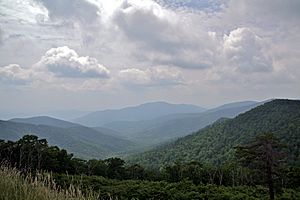
The park is famous for Skyline Drive. This 105-mile (169 km) road runs along the top of the mountains through the whole park. About 101 miles (163 km) of the Appalachian Trail are also in the park. In total, there are over 500 miles (805 km) of trails for hiking. You can also enjoy horseback riding, camping, bicycling, and seeing many waterfalls. Skyline Drive is a special road. It is the first National Park Service road east of the Mississippi River to be named a National Historic Landmark.
Backcountry Camping: Exploring the Wild
Shenandoah National Park offers 196,000 acres (793 km²) for backcountry and wilderness camping. When camping in the backcountry, you must follow "Leave No Trace" rules. This means burying waste and not building campfires.
Backcountry campers must also be careful of wildlife. This includes bears and venomous snakes. Campers should hang their food from trees in "bear bags" or use special bear canisters. This stops bears from getting human food. All animals in the park are protected by law.
Where to Stay: Lodges and Campgrounds
Campgrounds and Cabins
Most of the campgrounds are open from April to October or November. There are five main campgrounds:
- Mathews Arm Campground
- Big Meadows Campground
- Lewis Mountain Campground
- Loft Mountain Campground
- Dundo Group Campground
Park Lodges
There are three lodges or cabin areas:
- Skyland Resort
- Big Meadows
- Lewis Mountain Cabins

Lodges are found at Skyland and Big Meadows. The park's Harry F. Byrd Visitor Center is also at Big Meadows. Another visitor center is at Dickey Ridge.
Rapidan Camp is a restored fishing retreat. President Herbert Hoover built it in 1929. You can reach it by a 4.1-mile (6.6 km) round-trip hike on the Mill Prong Trail. The park also offers guided van trips to the camp.
Shenandoah National Park is very friendly to dogs. All campgrounds allow dogs. Dogs are allowed on almost all trails, including the Appalachian Trail. They must be on a leash (6 feet or shorter). Dogs are not allowed on ten specific trails. These trails are less than 20 miles (32 km) out of the park's 500 miles (805 km) of trails.
The streams and rivers in the park are popular for fly fishing for native brook trout.
Beautiful Waterfalls
Many waterfalls are found within the park. Here are some of the most important ones:
| Falls | Height | Location | Description |
|---|---|---|---|
| Overall Run | 93 ft (28 m) | Mile 21.1, parking lot just south of Hogback Overlook | The tallest waterfall in the park. It's a 6.5-mile (10 km) round trip hike. Visit before June as it can dry up. |
| Whiteoak Canyon | 86 ft (26 m) | Mile 42.6, Whiteoak Canyon parking area | This area has six waterfalls. The first and tallest is 86 feet (28 m). Not all falls are easy to reach. |
| Cedar Run | 34 ft (10 m) | Mile 45.6, Hawksbill Gap parking area | A difficult 3.4-mile (5 km) round trip hike. See waterfalls, swimming holes, and natural rock slides. |
| Rose River | 67 ft (20 m) | Mile 49.4, parking at Fishers Gap Overlook | A 2.6-mile (4 km) round trip hike. Can also be a longer loop hike. |
| Dark Hollow Falls | 70 ft (21 m) | Mile 50.7, Dark Hollow Falls parking area | A 1.4-mile (2 km) round trip hike. This is the closest and most popular waterfall near Skyline Drive. No pets are allowed here. |
| Lewis Falls | 81 ft (25 m) | Mile 51.4, parking lot just south of Big Meadows, next to a service road | A 2-mile (3 km) round trip hike. |
| South River Falls | 83 ft (25 m) | Mile 62.8, park at South River picnic area | A 3.3-mile (5 km) loop hike to an overlook. A rocky 1-mile (2 km) trail goes to the base of the falls. |
| Doyles River Falls | 28 and 63 ft (9 and 19 m) | Mile 81.1, Doyles River parking area | A 3-mile (5 km) round trip hike to see both upper and lower falls. |
| Jones Run Falls | 42 ft (13 m) | Mile 84.1, Jones Run parking area | A 3.6-mile (6 km) round trip hike. Can be a longer loop with Doyles River falls. |
Hiking Trails: Dark Hollow Falls
The Dark Hollow Falls Trail starts at mile 50.7 of Skyline Drive. This is near the Byrd Visitor Center. The trail goes downhill next to Hogcamp Branch to Dark Hollow Falls, a 70-foot (21 m) waterfall. The hike to the base of the falls is 0.7 miles (1.1 km). The trail continues past the falls, connecting to the Rose River fire road.
You can see different animals along the trail. Sometimes, you might spot black bears and timber rattlesnakes. The trail is short, but some parts are steep. This can make it a bit challenging. There is no view from the very top of the falls. It's also not safe to leave the trail because of slippery rocks.
Park Ecology
The plants and animals in Shenandoah National Park are typical for mountains in the eastern Mid-Atlantic region. Many common species also live at lower elevations.
Pine trees grow on the sunny, southwest sides of some hills. You might even find a prickly pear cactus there. On the cooler, northeast sides, you'll see dense groups of moisture-loving hemlocks and lots of mosses. Other common plants include oak, hickory, maple, tulip poplar, and mountain laurel. You'll also find milkweed, daisies, and many types of ferns.
The American chestnut tree used to be very common. But a fungus called the chestnut blight almost wiped them out in the 1930s. These trees still grow in the park, but they usually die before they get big enough to reproduce. Oak trees took their place and became the main type of tree. In the early 1990s, Gypsy moth outbreaks started. These moths mainly eat oak leaves. This has reduced the number of oak trees.
Park Wildlife
Mammals living in the park include black bears, coyotes, striped skunks, spotted skunks, raccoons, beavers, river otters, opossums, woodchucks, two types of foxes, white-tailed deer, and eastern cottontail rabbits. Some people have reported seeing cougars in remote areas, but this has not been proven.
Over 200 kinds of birds live in the park for at least part of the year. About 30 species stay all year. These include the barred owl, Carolina chickadee, red-tailed hawk, and wild turkey. The peregrine falcon was brought back to the park in the mid-1990s. By the late 1990s, many pairs were nesting there.
Thirty-two types of fish have been found in the park's waters. These include brook trout, longnose and eastern blacknose dace, and the bluehead chub.
Ranger Programs
Park rangers offer many programs from spring to fall. These include guided hikes led by rangers. They also have talks about the park's history, plants, and animals. "Shenandoah Live" is an online series. Here, you can chat live with rangers and learn about the park. Rangers discuss many topics and answer questions.
Artist-in-Residence Program
In 2014, Shenandoah National Park started an Artist-in-Residence Program. This program is run by the Shenandoah National Park Trust. Photographer Sandy Long was the first artist to be part of this program. Her work from the park was shown in a photography exhibit called "Wild Beauty: The Artful Nature of Shenandoah National Park."
See also
 In Spanish: Parque nacional Shenandoah para niños
In Spanish: Parque nacional Shenandoah para niños


